粽情端午
2016-05-02
粽情端午
DRAGON BOAT FESTIVAL IN CANTON: A ZONGZI BANQUET
Text by Ma Yanling Translation by Leo Photos by CFP

The “Dragon Boat Festival”, also called “Duanwu Festival”, is celebrated on the fifth day of the fifth month in the Chinese calendar (Jun. 9th in the Gregorian calendar this year). For more than 2,000 years, the festival, said to commemorate the death of Qu Yuan, a great poet and minister of the Warring State Period (475-221BC), has been marked by racing dragon boats, eating Zongzi (sticky rice dumplings wrapped in bamboo leaves), hanging mugwort leaves, painting children's foreheads, and wearing sachets. Two additional long-established customs of the Duanwu Festival in Guangdong Province are∶ soaking written charm ashes in water and washing hands in it before spraying it to the road (meant to repel bad luck), and flying kites - one may say they are quite superstitious. Nevertheless, the best ambassador for the festival has always been Zongzi. As this year's Duanwu Festival is on the way, Zongzi is certainly a most discussed topic at the moment.
The varieties of Zongzi made in Guangzhou are basically the same with those in the rest of the country - namely, sweet Zongzi, salty Zongzi and the very original alkaline Zongzi (glutinous rice blended with alkaline water). It is the shape and the fillings that differentiate Cantonese Zongzi from the others. Guangzhou sits on a plain generously endowed with resources and food supplies. This has privileged Cantonese people with a wide selection of ingredients and flavours when it comes to making fillings for Zongzi.
In most cases, Zongzi are either sweet or salty. One exception is the Zongzi found in Chaozhou area in eastern Guangdong. They are half salty with pork belly and chestnut fillings, and half sweet with red bean paste fillings. They also come with a packet of sweet dressings. Just break Zongzi into small chunks with your chopsticks, and dip them in the sauce. It is simply delicious! The Zongzi of this style sold at the Mazu Palace in Shantou city are one of the best known.
The Dragon Boat Festival is also a great time for all kinds of Zongzi to compete with one another. Some compete on the size while others compete on flavour. For instance, a vareity named “Treasure Zongzi” boasts a size 3 to 5 times bigger than normal Zongzi. But no matter how Zongzi evolves, three fundamental elements have remain unchanged∶ the rice, the leaves and the string.
Someday in the future when people replace these elements with plastic strings or aluminum foils, will we still call them Zongzi?
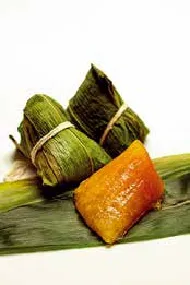
Alkaline Zongzi
The alkaline Zongzi is in fact, the simplest form of sweet Zongzi. Add warm water to dietary alkali (or baking soda), soak sticky rice in it, and wrap the rice into pyramidshaped Zongzi with bamboo leaves; put Zongzi in a pot of cold water, boil them on the stove until they are fully cooked, and allow them to simmer for another three to four hours for the best flavour. The lye water turns the plump rice grains into a semi-transparent yellow colour, and gives them a refreshing flavour and a texture which is neither too sticky nor too loose. The alkaline Zongzi can be eaten plain, or dipped in sugar, honey, or soy sauce as you like.
(Gaozhou, Shaoguan)

Sweet Zongzi
The Cantonese sweet Zongzi are usually bigger in size, and have a much wider selection of ingredients for the fillings than those of Northern China. Some common ingredients for sweet Zongzi fillings in Guangzhou are lotus seed paste, mung bean paste, red bean paste, and so on. Making sweet Zongzi generally follows the same steps with those in the making of alkaline Zongzi, except that different fillings are used. In addition to sticky rice, other ingredients can also be used to make sweet Zongzi - for example, a mixture of soaked purple rice and white sticky rice, stuffed with sweet fillings such as red bean or mung bean paste, is also a good option.
(Gaozhou, Shantou)

Salty Zongzi
The most common variety of Zongzi in Canton is the salty Zongzi, which is characterised by an extensive range of ingredients. They usually use shelled mung beans and pork belly meat for the fillings as well as sticky rice for the main ingredient, and are wrapped with bamboo leaves into a triangle shape. Other common fillings include ham, salted duck egg yolks, roasted chicken, barbecue pork, roasted duck, chestnuts, shiitake mushrooms, and shrimp. The mixture of different ingredients gives Zongzi multiple layers of flavour, both aromatic and savoury. All it takes is just one bite.
(Zhaoqing, Taishan, Shunde)
THE STEPS OF MAKING SALTY ZONGZI
咸粽制作流程
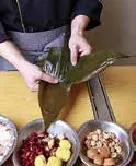
Prepare all the ingredients. Use two bamboo leaves, one on top of the other, to wrap the fillings.
准备好原料后,取两片粽叶交叉放置,用来包内馅。
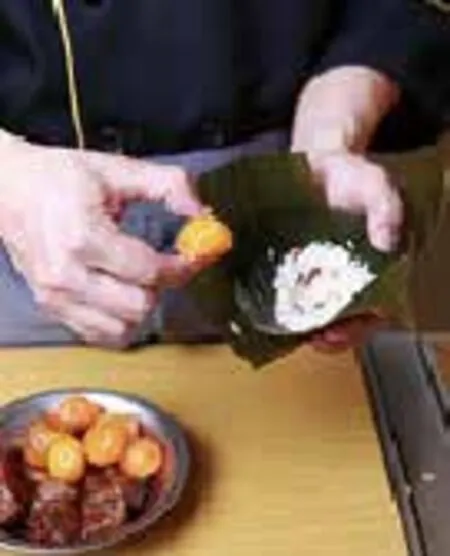
Shape bamboo leaves into a cone and add sticky rice into the cone before adding chestnuts, salted duck egg yolk or other ingredients of your liking.
粽叶弯曲成锥子形,放入白糯米后,再按个人喜好放栗子、咸蛋黄等。

Do not overload the cone with too much sticky rice. Leave half of the space for other ingredients. Tap down the ingredients while adding more.
注意糯米别放太多,留一半空间放其他馅料,边放边挤压,使之结实。
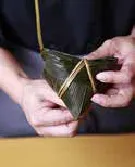
When all the ingredients are added, use the remaining bamboo leaves to wrap the whole thing up, and then bind it with string.
馅料包好后,用剩余的粽子叶包裹完整,再用绳子扎好。
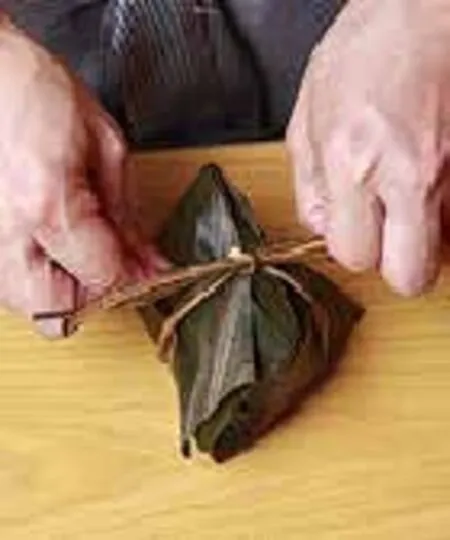
Make sure the string is tight enough to hold Zongzi in place while they are being cooked.
绳子一定要扎紧,下水后保证粽子不漏不松。
